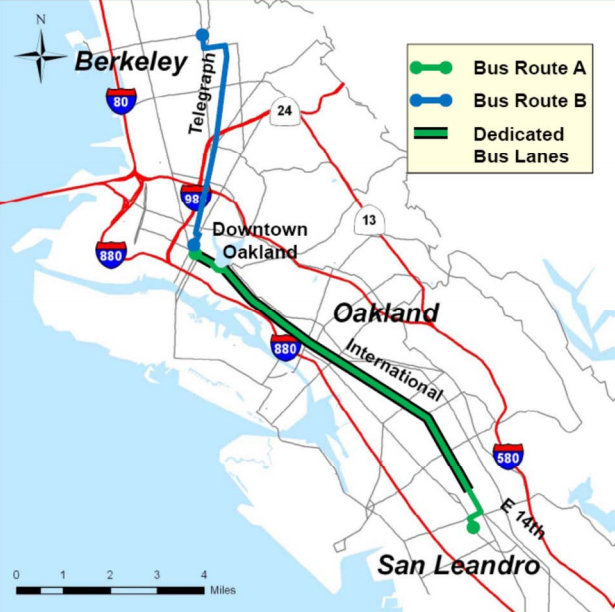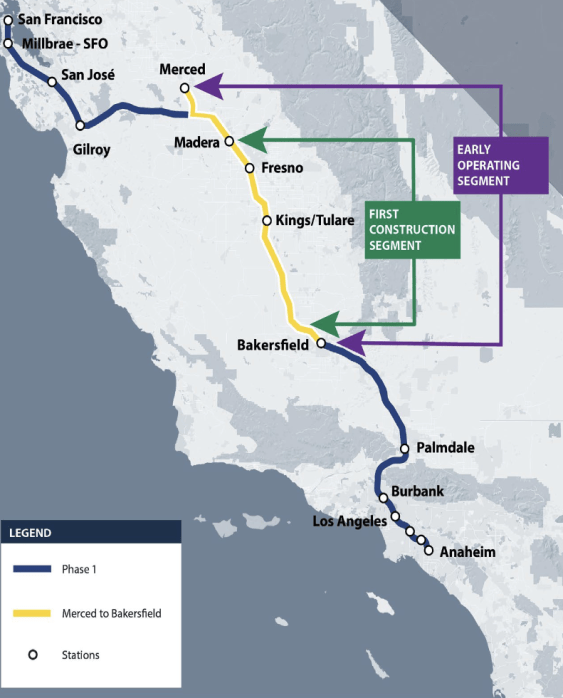Bay Area’s First BRT System Coming to the East Bay By 2016
2:11 PM PST on February 14, 2012
Transit riders in the East Bay will get a boost in 2016 with the arrival of the region's first Bus Rapid Transit corridor, connecting San Leandro and Oakland. The project recently reached a major milestone with the release of its final environmental impact report (EIR). AC Transit will begin fielding public feedback on the EIR next week, and construction could begin as soon as next year.
The project will speed up service on AC Transit Rapid Bus Routes 1 and 1R, primarily along International Boulevard from San Leandro BART Station to downtown Oakland. The BRT line is projected to increase transit speeds 39 percent, reduce automobile travel by 21,000 miles each day, lower operating costs, and spur transit-oriented growth along the roughly 14-mile corridor.
"BRT will bring a whole new level of efficiency, which will translate into quicker rides, more comfortable and more reliable rides that will attract more riders and dramatically improve this service that riders currently experience along the corridor," said Joél Ramos, a community planner at the Oakland-based TransForm who also sits on the SFMTA Board of Directors. San Francisco is currently developing BRT routes on Geary Boulevard and Van Ness Avenue, but the East Bay project is expected to open first.
East Bay BRT will be "the first significant amount of infrastructure investment in east Oakland for over 35 years," said Ramos. The route currently sees over 20,000 riders per day, and although BART runs parallel to it, Ramos pointed out that BRT improvements will create a more attractive option for those who can't easily walk to a BART station or only want to travel locally.
"The bus service actually serves people who live between BART stations," he said.
The BRT buses would feature doors on both sides to allow boarding at both center medians and curbside stops. Colored bus lanes, bus signal priority, and off-board fare collection will create and quicker and easier riding experience. In many places, the project would also add bike lanes, and streets should see calmer motor traffic with fewer vehicle lanes. The proposal will cost about $190 million.
While the exact alignment is still being finalized, Ramos said the route will likely run between the San Leandro BART Station and 20th Street in Oakland. Although the design favored by cities along the route (known as the "Locally Preferred Alternative") included an extension to downtown Berkeley, AC Transit is leaning away from it "due to business' concerns about loss of parking and neighborhood concerns about traffic diversion," according to the East Bay Bike Coalition.
Ramos said that because car congestion would likely create a bottleneck in the BRT system without dedicated lanes, the route would terminate at 20th Street, and Berkeley-bound riders would have to connect via a local bus (though that service would receive some improvements like off-board ticket machines).
Through TransForm's efforts to boost the project's outreach in recent years, Ramos said the planning process has included input from an especially broad demographic, such as non-English-speaking and lower-income communities who are typically excluded.
"Everyone we spoke to, for the most part, was excited about the project," said Ramos.
East Bay residents and commuters can submit comment on the project EIR until March 19, and AC Transit will hold a series of public meetings in Oakland and San Leandro beginning February 23.
Stay in touch
Sign up for our free newsletter





